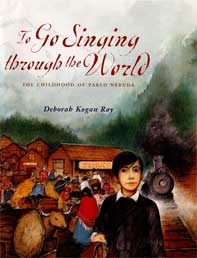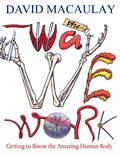Newsletter, Volume 14, Number 2
Welcome to our newsletter. If you'd like to have each issue delivered to your email address you can sign-up for a subscription.
New Book Reviews
In this issue I've gathered together reviews of several new books. There's a new collection of Edgar Allan Poe stories with essays by contemporary mystery writers, a very silly picture book, a picture book biography of Pablo Neruda, and a nonfiction book by David Macaulay on the human body.
If you use any of these with your students I'd love to hear about their reactions.
Short Stories, Gr 6-12

Connolly, Michael. ed. In the Shadow of the Master: Classic Tales by Edgar Allan Poe. (2009, Morrow. ISBN 9780061690396.) Fiction. Short stories. Three stars (out of 3). Gr 6-12.
No exploration of short stories is complete without reading Poe. If you are looking for an anthology of his stories I highly recommend this one.
This anthology includes essays by various mystery writers like Stephen King and Sue Grafton about how the reading of Poe has affected them. The experience of Poe as required reading in school comes up again and again. The "broccoli" that teenagers are required to eat. The essay writers often compare their early experiences of reading Poe with later readings when they were able to discover greater meaning.
These essays are a great follow-up after reading the stories but are also a good jumping off place for discussions about required reading and about revisiting texts later, how changes in the reader affect later readings. It's a good time to talk about what the reader brings to a story in general.
In the collection of Poe stories anthologized here you'll find old standards such as The Raven and The Pit and the Pendulum and lesser known stories like The Descent into the Maelstrom.
Reading these stories in the context of the essays creates a sense of joining a community of readers sharing these stories that so many of us have been affected by. For students it can be their first experience of sharing a readers' community that extends beyond the walls of the school.
Picture Book, Gr PreK-12

Lechner, Jack. Mary Had a Little Lamp. (2008, Bloomsbury. ISBN 9781599901695.) Picture Book. 3 stars. Gr PreK-12.
This book got me right in my funny bone. What a delight it was to find in the pile of new releases.
Mary has a little lamp, a gooseneck desk lamp, in fact. And yes, she takes it everywhere she goes. She loves the cool feel of it against her face and she loves the light it gives when she plugs in the cord that she drags it around by. Her parents:
"We just don't get it! Why a lamp? her worried parents said. 'We told her she could have a dog She wanted this instead!'"
The illustrations are bold and outrageous. A perfect match to this wry poem. The faces of people and animals are particularly expressive.
To the surprise of all Mary heads off to summer camp without her lamp and has a fabulous time. We think perhaps she's finally "normal" until we read the surprise ending. I highly recommend this book for all ages.
Picture Book, Biography, Gr 4-6

Ray, Deborah Kogan. To Go Singing Through the World: The Childhood of Pablo Neruda. (2006, Farrar, Straus and Giroux. ISBN 0374376271.) Picture Book. 3 stars. Gr 4-6.
Beautiful. It's just too predictable to use the word "lyrical" to describe this biography of Pablo Neruda's early years. But there you are, I've said it.
Ray weaves short passages of Neruda's prose and poetry into her narrative. The context makes the poetry more accessible. For instance, when Ray describes the tiny outpost of Temuco, Chili, a new mill town, where Neruda grew up, it helps us understand what Neruda is talking about when the book segues into a clip of his poetry,
"From axes and rain, it grew up, that town of wood recently carved, like a new star stained with resin."
In turn Ray's writing is strengthened by the integration of Neruda's words.
Born in 1904, Neruda lost his mother as an infant but became very close to his stepmother. Tortured by shyness and embarrassment about his stutter Pablo retreats more and more into his solitude. He finds comfort and a sense of belonging in books and writing.
Pablo Neruda went on to become the most celebrated literary figure in Latin America, a political activist, diplomat and senator. He won the Nobel Prize for literature in 1971.
The book speaks to many areas of the curriculum: poetry, finding one's voice, the outsider, biographies, South America, the 20th century, writing and the power of an individual.
Nonfiction, Gr 6-12

Macaulay, David. The Way We Work: Getting to Know the Amazing Human Body. (2008, Houghton. ISBN 9780618233786.) Nonfiction. 3 stars. Gr 6-12.
Macaulay has turned his able hand from The Way Things Work to "The Way We Work". Well written with fascinating drawings he breaks human anatomy and physiology into seven chapters: Building Life (cell structure), Air Traffic Control (respiration), Let's Eat (digestion), Who's in Charge Here (nervous system), Battle Stations (immune system), Moving On (skeletal and musculature), and Extending the Line (reproduction). Most of the 336 pages are covered with Macaulay's illustrations of body parts and processes. There are humorous touches like the "MOM" tatoo on the cross section diagram of a vaccination needle going into muscle tissue and the diving board in the illustration of the various types of cells that are suspended in the "pool" of plasma that makes up our blood.
Many of the drawings have that kind of tongue in cheek portrayal of what the - mostly straight faced - text is describing. Tiny tourists watch through binoculars on a deck overlooking the back of the throat as the tongue guides food down. Tiny angels with guide wires hold up the large intestine where it goes across the top. The distribution of oxygen is depicted as an amusement park ride.
This is a book to curl up with while reading the text, exploring the pictures and extending ones understanding of our body. As Macaulay says in the introduction, "Each of us owns and inhabits an exceptional example of biological engineering and one that deserves to be understood and celebrated."
This title is especially appropriate for middle school and high school students. Younger students might need help with the density of information. A good extension of or substitute for textbooks and a good source for report writing.
Use this book in health, biology and art classes.
Related Areas of Carol Hurst Children's Literature Site:
Other Related Websites:
- The Edgar Allan Poe Museum:
http://www.poemuseum.org/ - Deborah Kogan Ray's author web site
http://www.dkray.com/ - David Macaulay's author web site
http://www.davidmacaulay.com/
That's it for today. Happy reading!
Rebecca Otis
Advertisement:
Advertisement:
Advertisement:

